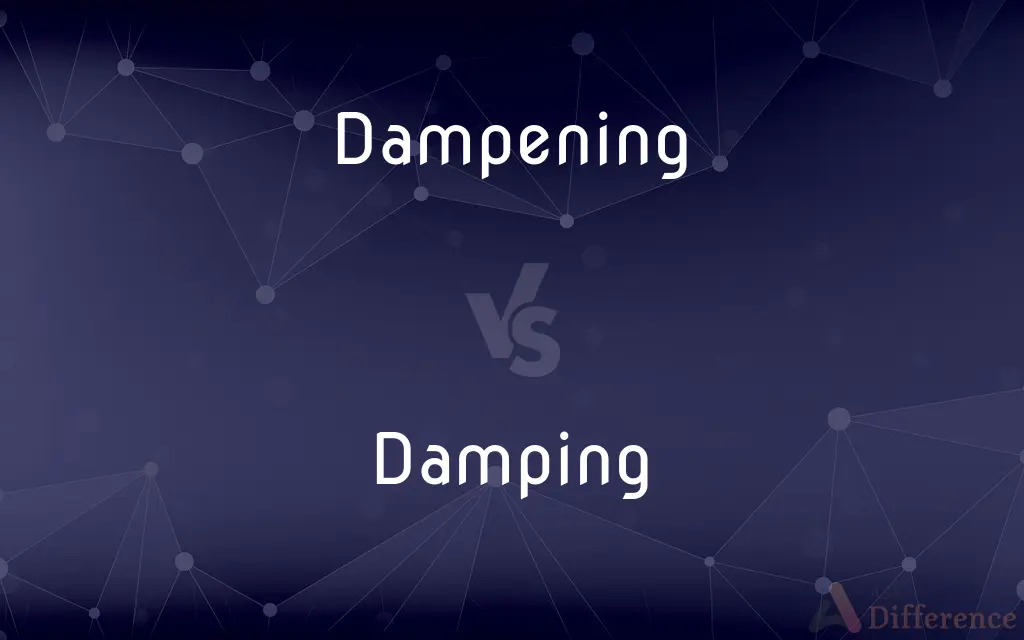Dampening vs. Damping — What's the Difference?
By Tayyaba Rehman & Urooj Arif — Updated on March 25, 2024
Dampening refers to making something slightly wet or reducing its intensity, while damping involves decreasing vibrations, oscillations, or emotional intensity.

Difference Between Dampening and Damping
Table of Contents
ADVERTISEMENT
Key Differences
Dampening is primarily associated with moisture or the act of making something damp, implying a physical change in the condition due to the addition of liquid. This term can also metaphorically refer to reducing the intensity or vigor of an activity or emotion. For example, a sudden rain can dampen spirits or enthusiasm for an outdoor event.
Damping, on the other hand, is a term often used in physics and engineering to describe the reduction of oscillatory movements through energy dissipation. This process is crucial in mechanical and structural design to prevent undesirable vibrations that can lead to structural failure or noise. In a broader sense, damping can also imply the reduction of emotional or metaphorical oscillations, such as calming heightened emotions or tensions.
While dampening might suggest a suppression or diminution of a quality, such as dampening one's mood, damping specifically targets the control or stabilization of dynamic systems, including mechanical components and emotional states. The distinction lies in damping's technical connotation of controlling kinetic energy and its applications beyond the physical realm into areas of psychological or emotional equilibrium.
The interchange of these terms occurs frequently in everyday language, but their specific technical or figurative applications reveal nuanced differences. Dampening, with its connotations of wetness and mild suppression, contrasts with damping's focus on targeted reduction of movement or intensity, whether in physical systems or in the realm of human emotions.
Comparison Chart
Primary Use
Making something wet or mildly reducing intensity
Reducing vibrations or emotional fluctuations
ADVERTISEMENT
Field
General use, including metaphorical contexts
Physics, engineering, and metaphorical contexts
Connotation
Wetness or mild suppression
Controlled reduction of oscillations or emotions
Example
Dampening a cloth, dampening enthusiasm
Damping vibrations in a bridge, damping fears
Outcome
Something becomes damp or less intense
Oscillations or emotional states are stabilized
Compare with Definitions
Dampening
Reducing intensity or vigor.
The unexpected news dampened the mood at the party.
Damping
Stabilizing emotional states.
Deep breathing exercises help in damping anxiety.
Dampening
Making slightly wet.
Dampening the cloth before wiping the dust off.
Damping
Controlling kinetic energy.
The shock absorbers are designed for effective damping of road bumps.
Dampening
Mild suppression.
His criticism dampened her enthusiasm for the project.
Damping
Reducing oscillations.
The suspension system is responsible for damping vibrations in the car.
Dampening
Softening impact or effect.
The heavy curtains helped in dampening the sound from outside.
Damping
Metaphorical calming.
The leader's speech was aimed at damping the unrest among the citizens.
Dampening
Metaphorical decrease.
The new policy could dampen economic growth.
Damping
Technical reduction of movement.
Engineers are focused on damping the structural vibrations of the skyscraper.
Dampening
To make damp.
Damping
Damping is an influence within or upon an oscillatory system that has the effect of reducing or preventing its oscillation. In physical systems, damping is produced by processes that dissipate the energy stored in the oscillation.
Dampening
To deaden, restrain, or depress
"trade moves ... aimed at dampening protectionist pressures in Congress" (Christian Science Monitor).
Damping
The gradual reduction of excessive oscillation, vibration, or signal intensity, and therefore of instability in a mechanical or electrical device, by a substance or some aspect of the device.
Dampening
To soundproof.
Damping
Present participle of damp
Dampening
To become damp.
Damping
(mechanics) The reduction in the magnitude of oscillations by the dissipation of energy
Dampening
Present participle of dampen
Damping
(mechanics) The stabilization of a physical system by reducing oscillation
Dampening
The act of making or becoming damp.
Dampening
The act or process of making something slightly wet.
Dampening
The act of making something slightly wet
Common Curiosities
Is dampening always related to moisture?
While primarily associated with moisture, dampening can also mean reducing the intensity of emotions, activities, or effects.
Can the term "damping" be used outside of physics?
Yes, damping can also metaphorically refer to reducing emotional or psychological fluctuations.
What is damping?
Damping is the process of reducing vibrations, oscillations, or emotional fluctuations through controlled means.
How does dampening affect materials?
Dampening can change the physical properties of materials by making them slightly wet, which may affect their weight, strength, or behavior.
Can something be both dampened and damped?
Yes, in scenarios where both a reduction in moisture and stabilization of movements or emotions are involved, both terms could be applicable.
How do cultural perceptions of dampening and damping differ?
Cultural perceptions may vary, with dampening often seen in a negative light when it suppresses positive emotions or activities, whereas damping can be viewed positively for its role in stability and comfort.
How does one achieve effective damping in a mechanical system?
Effective damping in mechanical systems can be achieved through materials, design choices, and technologies that absorb or dissipate energy.
What does dampening mean?
Dampening refers to the act of making something damp or slightly wet, or metaphorically, to reducing the intensity of something.
How do dampening and damping differ in application?
Dampening is broadly used for adding moisture or reducing intensity, while damping is specifically about reducing mechanical vibrations or emotional oscillations.
What is an example of damping in everyday life?
Examples include shock absorbers in vehicles damping road bumps or noise-cancelling headphones damping ambient sound.
Can dampening be beneficial?
Yes, dampening can be beneficial in contexts like reducing noise or softening emotional responses to prevent overreaction.
Is dampening a temporary state?
Dampening can be a temporary state, especially when related to moisture, as materials may dry out or conditions may change.
Why is damping important in engineering?
Damping is crucial in engineering to prevent structural failures, reduce noise, and enhance the longevity and performance of mechanical systems.
What are common devices that use damping?
Common devices include shock absorbers, vibration dampers in buildings, and noise-cancelling headphones.
Why might someone confuse dampening with damping?
The confusion may arise due to their similar spellings and overlapping metaphorical uses, despite their distinct primary meanings and applications.
Share Your Discovery

Previous Comparison
Unassembled vs. Disassembled
Next Comparison
Density vs. DestinyAuthor Spotlight
Written by
Tayyaba RehmanTayyaba Rehman is a distinguished writer, currently serving as a primary contributor to askdifference.com. As a researcher in semantics and etymology, Tayyaba's passion for the complexity of languages and their distinctions has found a perfect home on the platform. Tayyaba delves into the intricacies of language, distinguishing between commonly confused words and phrases, thereby providing clarity for readers worldwide.
Co-written by
Urooj ArifUrooj is a skilled content writer at Ask Difference, known for her exceptional ability to simplify complex topics into engaging and informative content. With a passion for research and a flair for clear, concise writing, she consistently delivers articles that resonate with our diverse audience.














































